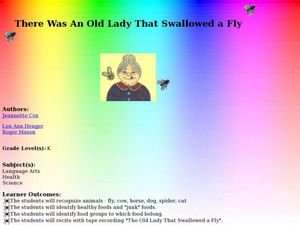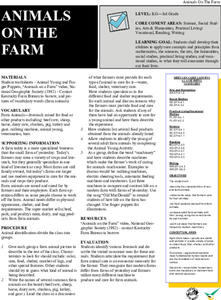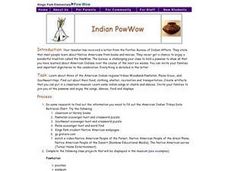American Museum of Natural History
What Do You Know About Horses?
A 10-question online quiz tests scholars' knowledge about horses: all answers come with an informative explanation.
Curated OER
Wild Horses
What a terrific resource! This presentation focuses on wild horses and what should be done about them. While the questions found in the presentation focus on grammar and comprehension, this set of slides could do so much more. Learners...
Curated OER
Horse Science ~ Digestive Physiology of the Horse
Everything you ever wanted to know about the digestive system of a horse is presented in this set of slides. Basic anatomy, factors that affect digestion, and the rate of the passage of food are all included. This may be useful to your...
Curated OER
There Was An Old Lady That Swallowed a Fly
Students complete activities with the book There Was An Old Lady That Swallowed a Fly. In this literature lesson, students hear the story and recognize the animals. They create fly soup and discuss healthy foods and junk...
Curated OER
Fourth Grade Science
In this science worksheet, 4th graders answer multiple choice questions about coastlines, electric cars, the food chain, and more. Students complete 25 questions.
Curated OER
Black Tiger Academy Martial Arts Fitness Unit – Lesson 12
“We are what we repeatedly do. Excellence therefore is not an act, it is a habit.”—Aristotle. Black Tiger Academy’s martial arts lesson plan 12 of 20 introduces the class to the amount of sugar contained in a variety of foods and drinks....
Curated OER
Food Trivia--Various 134
In this food trivia worksheet, students answer ten multiple choice questions based on their knowledge of food. This is an interactive worksheet.
Missouri Department of Elementary
Equine Science
Did you know that horses have two sets of teeth? There is much to learn about horses, of course, and those interested in equine science will learn much from a 10-lesson agricultural science course that covers not only equine dental...
American Museum of Natural History
Being a Zoologist: Sandra Olsen
Are your students wild about horses? Then introduce them Sandra Olsen, a zooarchaeologist, who has been studying horses and the people who herd them. Ms Olsen responds to 15 interview questions and details how she goes about her...
Curated OER
What Do They Eat?
What does a monkey eat? How about a squirrel? Introduce your young scholars to different types of eaters in the animal kingdom with this cut-and-paste activity. Students assess 6 animals: a squirrel, a frog, a monkey, a seal, a dog, and...
Aquarium of the Pacific
Amazing Adaptations
We can all adapt. Classmates watch a video about the adaptations of sea horses that allow them to eat and move. They then watch penguins on webcams to see what adaptations help the penguins find food, move, and avoid predators. Finally,...
Curated OER
A Meat By Any Other Name. . .
Students, using a New York Times article as a springboard, discuss how food reflects different aspects of a culture and reasons why cultural differences in food are seen as bizarre or, oftentimes, cruel by members of other societies.
Curated OER
Horse Warriors
Students compare the Roman Empire, medieval Europe and feudal Japan. In this warrior societies activity, students research the 3 warrior societies and share their research findings with their classmates.
Curated OER
They Don't Just Eat Grass
Students consider the USDA daily recommendations to create a "feed" product for middle schoolers. In this Health lesson, students learn about the ingredients in feed that is fed to livestock and apply the method to creating feed rations...
ProCon
Milk
Milk: It does a body good ... or does it? Using the provided website, scholars sort through information to answer the question. They review a chart demonstrating lactose intolerance by ethnicity and region, and they also compare the...
Curated OER
Animals on the Farm
Students work in groups to create a description of a farm animal. Other classmates try to guess the animal. The class discusses what farmers need to provide for each animal on their farm (food, shelter, veterinary care). Students...
Curated OER
Addition and Subtraction Word Problems
Here are three word problems that will put your scholars' addition and subtraction skills to the test! They read about penguins, horses, and hockey pucks, using images as clues. Since these problems have a lot of unnecessary information,...
Curated OER
Present Perfect – Have You Ever?
Designed for an English language development class, this worksheet is more like a treasure hunt. Learners walk around the room looking for others who have done a certain thing, like ride a horse. They use these prompts to practice asking...
Curated OER
Chinese New Year
Students investigate the celebration of Chinese New Year. In this Chinese New Year lesson, students discuss their favorite holiday before listening to a read aloud about Chinese New Year. They make red envelopes that are filled with play...
Curated OER
The Salmon Stream and Vegetation
Students explore the ecosystem and food chain by researching Pacific Salmon. In this fish habitat lesson, students discover the life cycle for salmon, where they spawn and what they eat to survive the harsh elements. Students participate...
Curated OER
Indian PowWow
Students identify three different American Indian regions and tribes, their food, clothing, shelter, recreation, and transportation. Students create artifacts that can be placed in a museum. Students sing songs, chants, and dance. ...
Curated OER
Better Butter
Young scholars explore the process of making butter. In this agriculture lesson plan, students discuss how butter is made today and how it was made in the past. Young scholars make their own butter using baby food jars and some "elbow...
Curated OER
What Are Cells?
Energize the cells of young biologists with an edible life science activity. Engaging students in exploring the inner workings of plant and animal cells, this activity involves using colored jello and various sweet and...
Curated OER
They Don't Just Eat Grass
Middle schoolers explore and examine different types of feed used for livestock. They discuss types of feed, the need for energy and health, and create graphs of food compared to categories. Students organize data and complete worksheets...

























